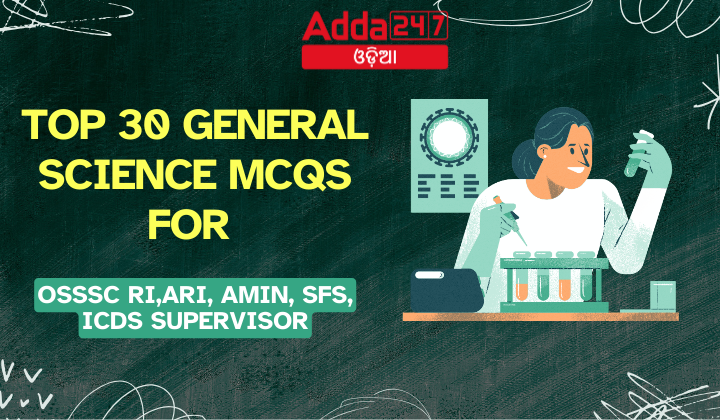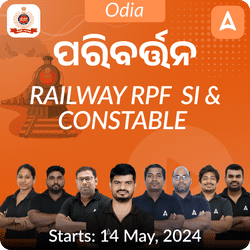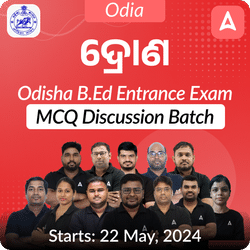General Studies is a crucial component of various competitive exams like OSSSC RI, ARI, Amin, SFS, and ICDS Supervisor. It encompasses a wide range of topics, from current affairs to history, geography, polity, and more. To excel in these exams, it’s essential to have a strong grasp of general knowledge. Here, we present a curated list of the top 30 Multiple Choice Questions (MCQs) that are commonly encountered in these exams, covering diverse subjects to help you prepare effectively.
Top 30 General Science MCQS For OSSSC RI,ARI, Amin, SFS, ICDS Supervisor
- Which institution’s scientist discovered the new species of wild okra in Odisha?
A) Odisha University of Agriculture and Technology
B) Indian Council of Agricultural Research (ICAR)
C) National Institute of Science Education and Research
D) Kalinga Institute of Industrial Technology
Answer: B) Indian Council of Agricultural Research (ICAR) - What is the name of the newly discovered 14th species of wild okra in Odisha?
A) Abelmoschus Odishae
B) Abelmoschus Indicus
C) Abelmoschus Bengalensis
D) Abelmoschus Sativus
Answer: A) Abelmoschus Odishae - How high can the newly discovered wild okra plant grow?
A) Up to 2 meters
B) Up to 3 meters
C) Up to 4 meters
D) Up to 5 meters
Answer: D) Up to 5 meters - What is the percentage increase in maize production in Odisha under the Mukhyamantri Maka Mission (MMM)?
A) 45%
B) 50%
C) 51%
D) 55%
Answer: C) 51% - What is the budget allocation for the Mukhyamantri Maka Mission over five years?
A) Rs 381.94 crore
B) Rs 421.94 crore
C) Rs 481.94 crore
D) Rs 501.94 crore
Answer: C) Rs 481.94 crore - What was the anemia level in Odisha as per the recent study conducted by the state government?
A) 36.7%
B) 46.7%
C) 56.7%
D) 66.7%
Answer: B) 46.7% - What scheme was rolled out to monitor and tackle anemia in Odisha?
A) Anaemia Nirvana Abhiyan
B) Anaemia Mukta Odisha
C) Anaemia Free Odisha Mission
D) Anaemia Mukta Laqshya Abhiyan (Amlan)
Answer: D) Anaemia Mukta Laqshya Abhiyan (Amlan) - Which of the following is not present in animal cells?
A) Cell walls
B) Mitochondria
C) Ribosomes
D) Cytoplasm
Answer: A) Cell walls - What is the objective of mixing Methyl tert-butyl ether (MTBE) with petroleum?
A) Raise Octane Number
B) Antioxidant Stabilizer
C) Lead Scavenger
D) Fuel Dye
Answer: A) Raise Octane Number - Which compound is known as White Vitriol?
A) Zinc Sulphate
B) Zinc Chloride
C) Zinc Phosphate
D) Zinc Oxide
Answer: A) Zinc Sulphate - A goitre is also called as?
A) Bronchocele
B) Larynx
C) Autoimmune disease
D) Inflammation
Answer: A) Bronchocele - Bile is collected in which organ?
A) Liver
B) Gall Bladder
C) Duodenum Canal
D) Spleen
Answer: B) Gall Bladder - Which of the following is made from wood cellulose?
A) Rayon
B) Balata
C) Cork
D) None of the above
Answer: A) Rayon - For which disease was the first successful vaccination developed?
A) Cowpox
B) Chickenpox
C) Smallpox
D) Polio
Answer: C) Smallpox - “Pratham,” the first animal born in 1990 by IVF (In vitro Fertilization) at the National Dairy Research Institute, Karnal, was a ________?
A) Cow
B) Buffalo
C) Sheep
D) Goat
Answer: B) Buffalo - What is the time taken by the Earth to complete one rotation about its axis with regard to a fixed star?
A) Sidereal day
B) Solar day
C) Shake
D) Tropical year
Answer: A) Sidereal day - The centripetal force and centrifugal force are ______?
A) Equal in magnitude and have the same direction
B) Unequal in magnitude and have the same direction
C) Equal in magnitude and have opposite directions
D) Unequal in magnitude and have opposite directions
Answer: C) Equal in magnitude and have opposite directions - Which of the following represents the angular frequency of a body?
A) Twice the frequency of the body
B) Product of frequency of the body with π
C) Half the frequency of the body
D) Product of frequency of the body with 3π
Answer: A) Twice the frequency of the body - Which of the following is correct about transverse mechanical waves?
A) They can travel through solids and gases
B) They can travel through solids but not liquids
C) They can travel through solids and liquids
D) They can travel through gases but not solids
Answer: B) They can travel through solids but not liquids - The longest external organ in the human body is?
A) Skin
B) Liver
C) Small Intestine
D) Large Intestine
Answer: A) Skin - The largest gland in the human body is?
A) Pancreas
B) Liver
C) Thyroid
D) Adrenal gland
Answer: B) Liver - What is the main component of natural gas?
A) Methane
B) Ethane
C) Propane
D) Butane
Answer: A) Methane - Which gas is used in the manufacture of vanaspati from vegetable oil?
A) Hydrogen
B) Nitrogen
C) Oxygen
D) Carbon dioxide
Answer: A) Hydrogen - Which among the following is a renewable source of energy?
A) Coal
B) Natural Gas
C) Solar Energy
D) Petroleum
Answer: C) Solar Energy - Which of the following elements is used in the filaments of an electric bulb?
A) Copper
B) Iron
C) Tungsten
D) Aluminum
Answer: C) Tungsten - Which is the most abundant gas in the Earth’s atmosphere?
A) Oxygen
B) Carbon Dioxide
C) Nitrogen
D) Hydrogen
Answer: C) Nitrogen - The boiling point of water is:
A) 90°C
B) 100°C
C) 110°C
D) 120°C
Answer: B) 100°C - Which university in Odisha has been selected as a nodal centre for the Smart India Hackathon (SIH) Software Edition 2023?
A) Utkal University
B) Ravenshaw University
C) CV Raman Global University
D) Sambalpur University
Answer: C) CV Raman Global University - Berhampur University signed an MoU with which organisation for collaborative research on marine ecology?
A) Bay of Bengal Programme Inter-Governmental Organisation (BOBP-IGO)
B) Indian Ocean Marine Research Association (IOMRA)
C) South Asian Marine Ecology Initiative (SAMEI)
D) International Marine Ecology Consortium (IMEC)
Answer: A) Bay of Bengal Programme Inter-Governmental Organisation (BOBP-IGO) - Which vitamin is produced in the human body when exposed to sunlight?
A) Vitamin A
B) Vitamin B
C) Vitamin C
D) Vitamin D
Answer: D) Vitamin D










